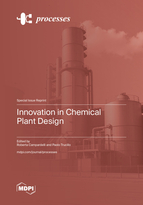Innovation in Chemical Plant Design
A special issue of Processes (ISSN 2227-9717). This special issue belongs to the section "Chemical Processes and Systems".
Deadline for manuscript submissions: closed (15 May 2022) | Viewed by 20386
Special Issue Editors
Interests: emulsions; nanoparticles; microparticles; nanofibers; drug delivery; biopolymers; food packaging; natural bioactive compounds; innovative technologies; chemical engineering; processes
Special Issues, Collections and Topics in MDPI journals
Interests: liposomes; microparticles; targeted delivery; pharmaceuticals, stimuli induced delivery; process scale-up; process economic analysis; air quality monitoring; hydrometallurgy; platinum group metals; coatings
Special Issues, Collections and Topics in MDPI journals
Special Issue Information
Dear Colleagues,
Chemical engineering can develop solutions for most important problems providing food, pharmaceutics, potable water, goods, and energy to a growing population. Satisfying these needs via conventional methods would be impossible and potentially disastrous for the planet. Therefore, significant research has been undertaken to improve productivity and yield of crops, reduce environmental impact, improve energy and water consumption, and enable sustainable use of resources and raw materials.
Generally, the field of application in chemical processes is not considered as innovative as the electronics, communications, and technology sectors. However, in recent years, chemical engineering has experienced serious innovations in areas such as:
- process intensification
- alternative and clean energy systems
- sustainable production processes (reduction of waste generation and water consumption, greater energy efficiency and higher yields of the desired product)
- automation systems that can optimize production and quality, reducing production costs
- nanotechnology and nanomaterials
- food and agriculture
- advanced pharmaceuticals
- more-sustainable building and construction materials
The aim of this Special Issue of Processes on the topic “Innovation in Chemical Plant Design” is to highlight recent innovation in chemical engineering process design and to point out trends and perspectives. Research works about process intensification, alternative and clean energy systems, sustainable production processes, process optimization, novel nanotechnology and nanomaterials, innovation in food production and product for agriculture, novel pharmaceuticals, and innovative materials for buildings are welcome.
Prof. Dr. Roberta Campardelli
Dr. Paolo Trucillo
Guest Editors
Manuscript Submission Information
Manuscripts should be submitted online at www.mdpi.com by registering and logging in to this website. Once you are registered, click here to go to the submission form. Manuscripts can be submitted until the deadline. All submissions that pass pre-check are peer-reviewed. Accepted papers will be published continuously in the journal (as soon as accepted) and will be listed together on the special issue website. Research articles, review articles as well as short communications are invited. For planned papers, a title and short abstract (about 100 words) can be sent to the Editorial Office for announcement on this website.
Submitted manuscripts should not have been published previously, nor be under consideration for publication elsewhere (except conference proceedings papers). All manuscripts are thoroughly refereed through a single-blind peer-review process. A guide for authors and other relevant information for submission of manuscripts is available on the Instructions for Authors page. Processes is an international peer-reviewed open access monthly journal published by MDPI.
Please visit the Instructions for Authors page before submitting a manuscript. The Article Processing Charge (APC) for publication in this open access journal is 2400 CHF (Swiss Francs). Submitted papers should be well formatted and use good English. Authors may use MDPI's English editing service prior to publication or during author revisions.
Keywords
- innovative solutions for chemical processes
- clean energy processes
- process optimization
- novel nanotechnologies
- materials for innovative applications
- innovations in food production
- novel agriculture solutions
- life cycle assessment
- novel pharmaceutical formulations process intensification







